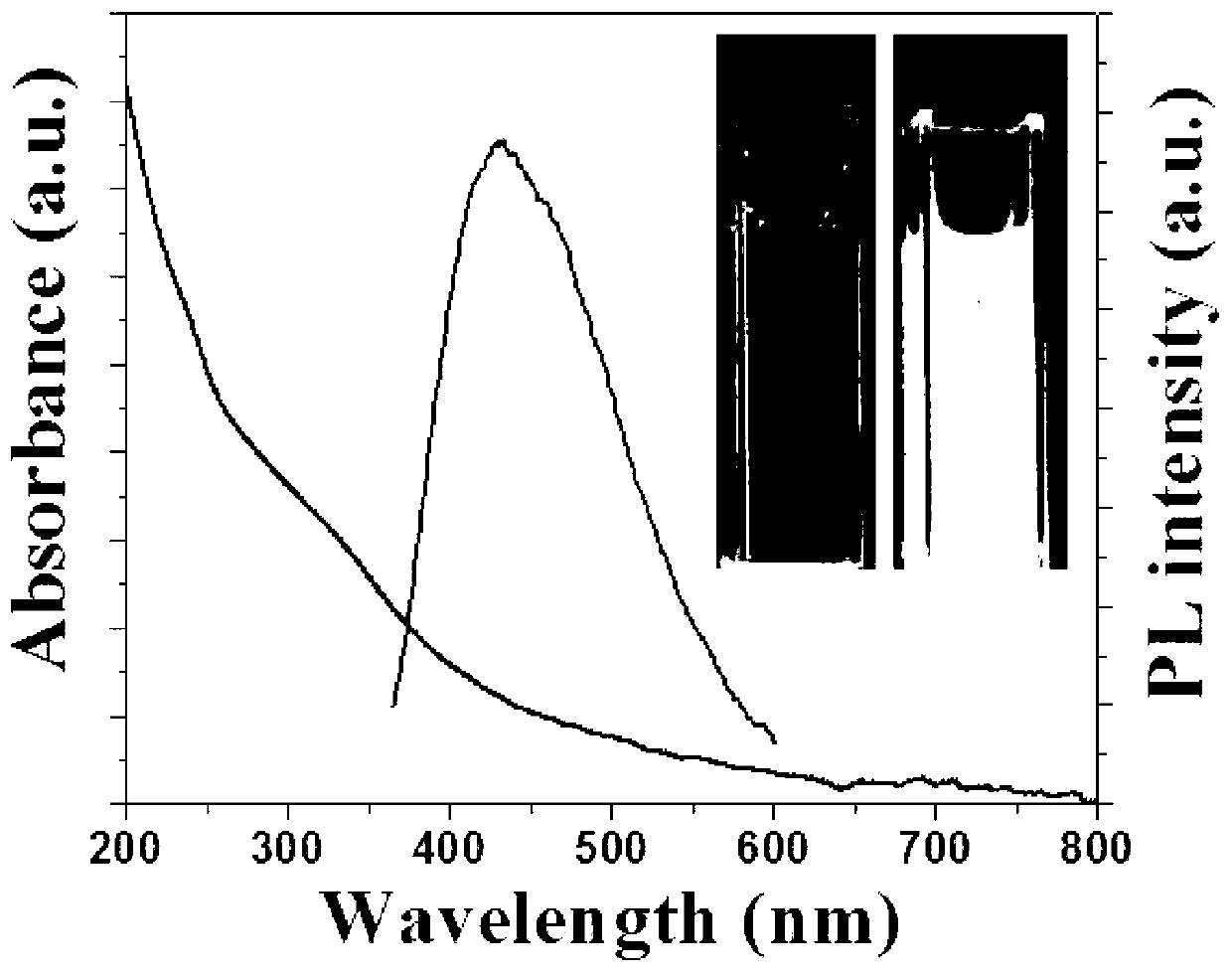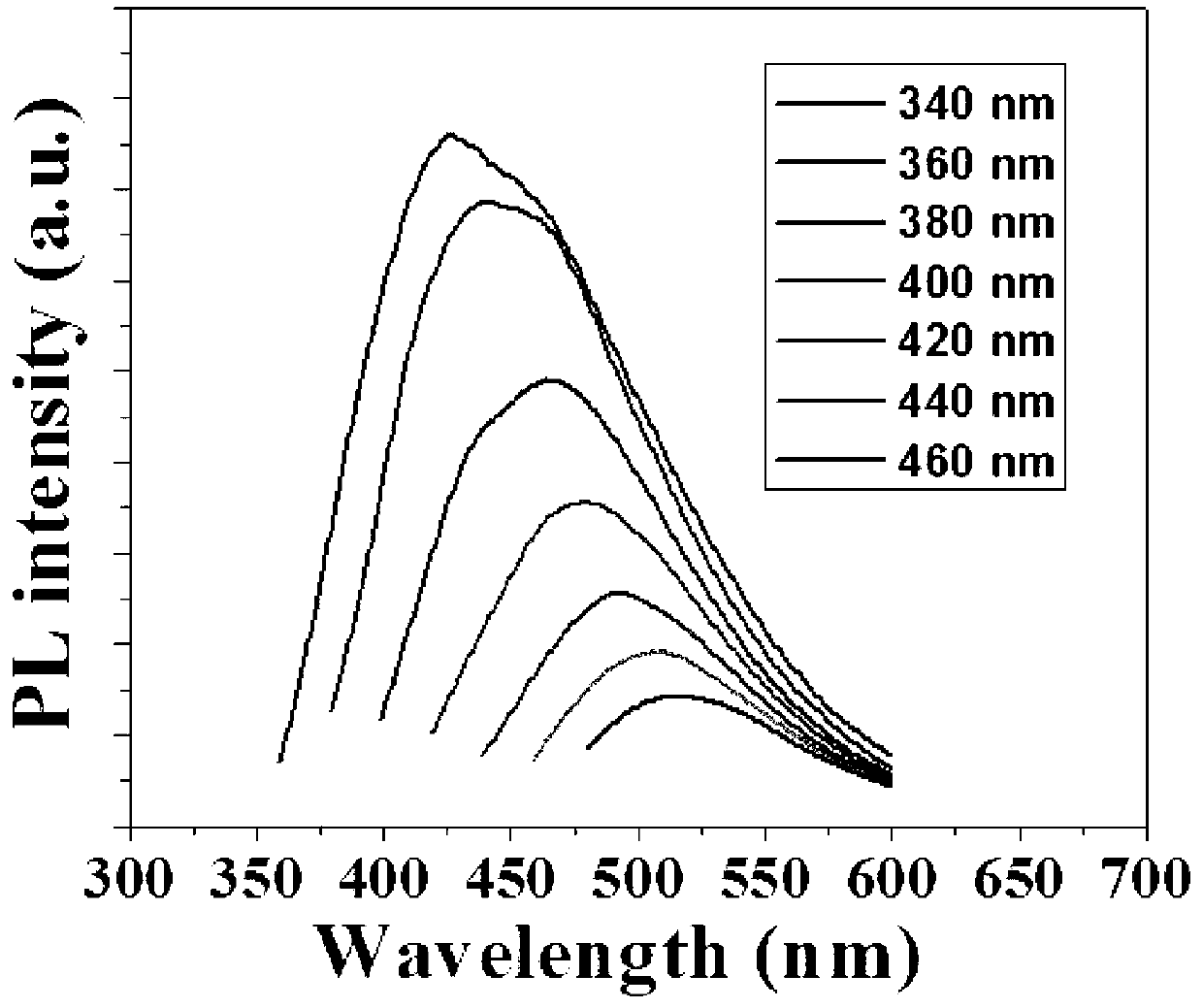Preparation method of carbon quantum dots with high fluorescence property
A carbon quantum dot and fluorescence technology, which is applied in the fields of nanomaterials and medical engineering, can solve the problems of restricting the large-scale production and practical application of fluorescent carbon quantum dots, complicated subsequent processing methods, uneconomical and environmental protection, etc., and achieves low steric hindrance, High fluorescence performance, simple equipment effect
- Summary
- Abstract
- Description
- Claims
- Application Information
AI Technical Summary
Problems solved by technology
Method used
Image
Examples
Embodiment 1
[0029] Example 1: Put 0.1g of glycine and 0.9g of glucose powder into a 100mL beaker, then pour 20ml of deionized water into the beaker, and stir magnetically at room temperature (15-25°C) until the glycine and glucose powder are fully dissolved , to obtain a uniform and transparent solution; the above solution was added to a 50ml polytetrafluoroethylene liner, put into a stainless steel reaction kettle, and heated in an electric oven at a constant temperature of 180°C for 3h to obtain a light yellow solution containing carbon quantum dots. After the solution is naturally cooled, filter with a medium-speed filter paper to remove insoluble black precipitates, centrifuge at 15,000g to remove large particles, collect the supernatant and inject it into a dialysis bag with a molecular cutoff of 1,000Da for dialysis, the dialysis time is 72h, and change it every 12h water. The dialyzed product was rotovaped to obtain a concentrated solution. The concentrated solution is freeze-drie...
Embodiment 2
[0030] Example 2: Put 0.2g of glycine and 0.8g of glucose powder into a 100mL beaker, then pour 20ml of deionized water into the beaker, and stir magnetically at room temperature (15-25°C) until the glycine and glucose powder are fully dissolved , to obtain a uniform and transparent solution; the above solution was added to a 50ml polytetrafluoroethylene liner, put into a stainless steel reaction kettle, and heated in an electric oven at a constant temperature of 180°C for 3h to obtain a light yellow solution containing carbon quantum dots. After the solution is naturally cooled, filter with a medium-speed filter paper to remove insoluble black precipitates, centrifuge at 15,000g to remove large particles, collect the supernatant and inject it into a dialysis bag with a molecular cutoff of 1,000Da for dialysis, the dialysis time is 72h, and change it every 12h water. The dialyzed product was rotovaped to obtain a concentrated solution. The concentrated solution is freeze-drie...
Embodiment 3
[0031] Example 3: Put 0.5g of glycine and 0.5g of glucose powder into a 100mL beaker, then pour 20ml of deionized water into the beaker, and stir magnetically at room temperature (15-25°C) until the glycine and glucose powder are fully dissolved , to obtain a uniform and transparent solution; the above solution was added to a 50ml polytetrafluoroethylene liner, put into a stainless steel reaction kettle, and heated in an electric oven at a constant temperature of 180°C for 3h to obtain a light yellow solution containing carbon quantum dots. After the solution is naturally cooled, filter with a medium-speed filter paper to remove insoluble black precipitates, centrifuge at 15,000g to remove large particles, collect the supernatant and inject it into a dialysis bag with a molecular cutoff of 1,000Da for dialysis, the dialysis time is 72h, and change it every 12h water. The dialyzed product was rotovaped to obtain a concentrated solution. The concentrated solution is freeze-drie...
PUM
| Property | Measurement | Unit |
|---|---|---|
| diameter | aaaaa | aaaaa |
Abstract
Description
Claims
Application Information
 Login to View More
Login to View More - R&D
- Intellectual Property
- Life Sciences
- Materials
- Tech Scout
- Unparalleled Data Quality
- Higher Quality Content
- 60% Fewer Hallucinations
Browse by: Latest US Patents, China's latest patents, Technical Efficacy Thesaurus, Application Domain, Technology Topic, Popular Technical Reports.
© 2025 PatSnap. All rights reserved.Legal|Privacy policy|Modern Slavery Act Transparency Statement|Sitemap|About US| Contact US: help@patsnap.com



